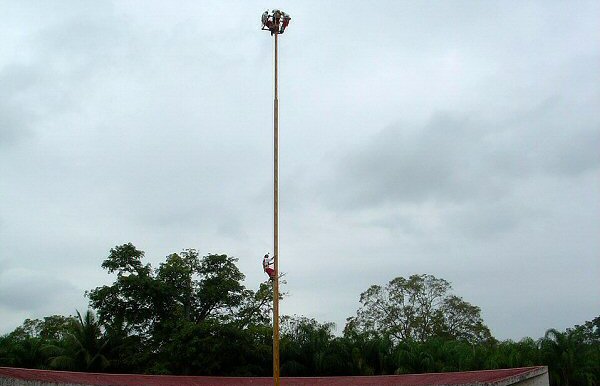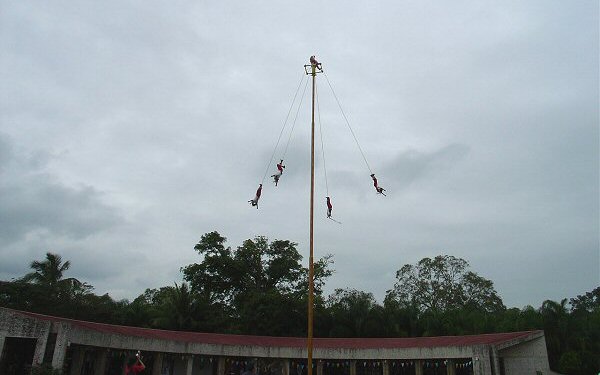Voladores (Video).
Northern Veracruz, Mexico
Travel & Tour
Pictures, Photos, Images, Information, Reviews.
George & Eve DeLange
Google Map To El Tajin Archaeological Ruins, Veracruz, Mexico.
View Larger Map
We Are Proud Of Our SafeSurf Rating!
Click On Any Of The Following Links By Amazon.Com
For Books Or Videos About Touring El Tajin, In Mexico. No Obligation!
Audrey and I were in the town of Papantla, the vanilla growing capital of Mexico and we heard that when we were to visit the nearby ruins of El Tajin we should watch for "The Voladores."
We learned that many people who've never been to the Gulf Coast -- or even to Mexico - will light up in recognition at the mention of the Voladores. But, until now, Audrey and I had never heard of them. They perform regularly throughout Mexico, Central and South America. They've even performed in several cities in the United States, Paris, and Madrid.
So, who are the Voladores, and why are they famous? And what do they have to do with the vanilla capital of Papantla?
The word Volador means flyer - "he who flies." It is wonderful to watch the spectacle of four men gracefully "flying" upside down from a 100 foot pole secured only by a rope tied around their waists.
After the voladores climb to the top of the poll a musician, called the Caporal balances on a narrow wooden platform without a rope or safety net, he then plays a drum and flute and invokes an ancient spiritual offering in the form of a spectacular dance.
The Caporal will then turn to face the four cardinal directions, he will also bend his head back to his feet, balance on one foot then lean forward, and perform intricate footwork, all the time playing the flute and drum! This part of the performance is perhaps the most astonishing.
The history of the ceremonial flight of the Voladores is shrouded in the mists of antiquity. Information about the original ritual was partially lost when the conquerors from Spain destroyed so many of the documents and codices of the indigenous cultures. Fortunately, enough survived through legend and oral history and in materials written by early visitors to New Spain, that anthropologists and historians have been able to document at least part of the story of this ancient religious practice and how it has evolved through time.
You might ask who the Totonacs were.
Archaeologists are fairly sure that the Totonacs were the builders of a number of sites, including the pyramids at El Taj�n, in the Lowlands of Veracruz.
Quoting from the Catholic Encyclopedia the Totonacs were; "one of the smaller cultured nations of ancient Mexico, occupying at the time of the Spanish conquest the coast province of Totonicapan, comprehending all except the northern border of the present State of Vera Cruz, together with the Zacatlan district in Puebla. Within this territory they had some fifty towns, with a total population of perhaps a quarter of a million. Their capital, Cempoala, about five miles inland from the present city of Vera Cruz, had a population of about 25,000. In spite of wars, epidemics, and oppressions they still number about 100,000."
"The Totonac were the first natives whom Cort�s met on landing in Mexico in 1519. According to their own traditions, they had come from the north-west nearly eight centuries earlier, and had maintained an independent kingdom--of which the names of the successive kings are on record--until subjugated by the Aztec only about twenty-five years before the arrival of the Spaniards. Being compelled by their conquerors to the payment of a heavy tribute and to other exactions, including the frequent seizure of their people for slaves or for sacrifice in the bloody Aztec rites, they were ripe for revolt, and their king, Chicomacatt, eagerly welcomed Cort�s and promised the support of his fifty thousand warriors against Montezuma.
It was largely due to their support that Cortez was able to conquer the Aztecs.
A Totonaca myth tells of a time in the 13th century when there was a great drought, causing food and water grew scarce throughout the land. Five young men decided that they must send a message to Xipe Totec, God of fertility so that the rains would return and nurture the soil, and their crops would again flourish. So they went into the forest and searched for the tallest, straightest tree they could find.
When they came upon the perfect tree, they spent the night, fasting and praying for the tree's spirit to help them in their quest. The next day they blessed the tree, cut it down, and carried it back to their village, never allowing it to touch the ground. Only when they decided upon the perfect place for their ritual, did they set the tree down.
The men stripped the tree of its leaves and branches, dug a hole to stand it upright, then blessed the site with ritual offerings. The men adorned their bodies with feathers so that they would appear like birds to Xipe Totec, in hope of attracting the god's attention to their important request. With vines wrapped around their waists, they secured themselves to the pole and made their plea through their flight and the haunting sound of the flute and drum.
In Mesoamerican times the ritual of the Volador was performed throughout much of Mexico. It was performed once every 52 years at the change of the century, and the brotherhood of the Voladores was passed from father to son.
At the time of the Conquest, the church fought strongly against what it considered heathen practices, and indigenous worship and rituals were silenced or held in secret. Later, the Catholic Church combined native beliefs with religious dogma, creating a syncretization of faith. The flight of the Volador was considered an interesting game by Colonial New Spain, and special plazas were constructed where the Voladores performed for a curious public. Over time the ritual slowly died out, until finally the Totonaca and a few Otomi were the only groups performing this ancient practice.
Today, the Totonaca people perform the flight of the Voladores for several reasons. First, it keeps a part of their traditional culture alive for everyone to see. Second, it provides additional income for the Voladores and their families. And it provides a sense of group pride.
The Voladores were among the first cultivators of vanilla, and many of them continue to grow it today. The Voladores comprised an elite segment of the Totonaca society. Vanilla continues to have a sacred place in the lives of the Totonaca in the same way as the flight of the Volador, and the two have remained integrally connected.
The Voladores are a source of great pride to everyone in Totonocapan - the region of the Totonaca. In Papantla, the hub of the vanilla industry, there is even a large stone Volador that looks down on the city from one of the highest points in town.
Like many legends, there is another story, which we think is interlinked into the story we have just told.
The Totonaco Nation, of Papantlas, began this spiritual ritual after their beloved King Flatchutanechi died. During his rule, the Nation became stronger and more prosperous than ever before. After his death, the Nation faltered and became weak. In this spiritual ceremony, the dancers are praying to the Creator for another king with the wisdom and strength of King Flatchutanechi.
Flatchutanechi ruled for 52 years, and to honor that, each year of his reign the voladores circle the pole 13 times. Multiplied by the four voladores, it equals 52 spins which represents the number of years the King ruled and the number of weeks in each year. The dancer on top of the 100 foot high pole is praying to the four directions with his music and dance.
The top of the pole is approximately 10" in diameter. It is important to note that the wooden frame from which the dancers descend is not attached to the pole. To maintain balance, dancers must be of similar weight. The dancers are not acrobats and this is not a circus act. Rather, dancers chosen as participants in the spiritual Dance of the Voladores are very honored.
The colorful traditional outfits are a prayer to the colors of Mother Nature and the 4 elements - fire, water, air and earth. Blue is for sky, yellow for the sun, red for fire and green for trees. White represents purity.
By the time the Europeans arrived in this part of the world, the Totonacos had been performing this ceremony for over 200 years. They continue this ancient tradition because they have never lost faith in the Creator, nor given up hope.
We enjoyed the ceremony and we are including parts of it here on our page for your enjoyment.
Holiday Inn
POZA RICA AEROPUERTO
KM 6.5 CARRETERA MEXICO TUXPAN TIHUATL N
POZA RICA, 92902 MEXICO
We suggest getting a hotel in the Poza Rica de Hidalgo area and then letting them arrange either a car or a tour of Poza Rica de Hidalgo and/or El Tajin.
If you call the hotels Concierge Services ahead of your arrival, all of this can be pre-arranged for you.
We do this all the time, when traveling in Mexico. It is safe and it works!!! We have never experienced a problem doing it this way!
El Taj�n International Airport (IATA: PAZ, ICAO: MMPA) is an international airport located near Poza Rica, Veracruz, Mexico. The airport is named after the archeological site of El Taj�n. It handles national and international air traffic for the city of Poza Rica. It's operated by Aeropuertos y Servicios Auxiliares, a federal government-owned corporation.
Therefore, we have placed a link to Priceline.com on this page so you can arrange your flights into and out of Poza Rica de Hidalgo, Mexico; as well as your hotel, when visiting this area. We also have links to Holiday Inn.

This Is The Ancient Totonac Dance
Performed To All Cardinal Directions
Click Here To See And Hear A Video Of The Voladores. 925kb File

This Is The Voladores
Performing The Ancient Totonac Rite Of Flight.
Click Here To See And Hear A Video Of The Voladores Totonac Rite Of Flight. 913kb File
We Are Proud Of Our SafeSurf Rating!
Click On Any Of The Following Links By Amazon.Com
For Books Or Videos About Touring In Mexico. No Obligation!
Click On The Bottom Link Marked GO, Then Look At The Bottom Of The Page That Comes Up.
There You Will See Travel Agencies That Are Recommended By Amazon.Com
For Touring In Mexico. No Obligation!
Here Are Some Links To The Very Best & Most Popular Items Sold On Amazon.Com
To Learn More! Click The Links Below. No Obligation, Of Course!
Other El Tajin Pages!
Audrey and I were in the town of Papantla, the vanilla growing capital of Mexico and we heard that when we were to visit the nearby ruins of El Tajin we should watch for "The Voladores." We learned that many people who've never been to the Gulf Coast -- or even to Mexico - will light up in recognition at the mention of the Voladores. But, until now, Audrey and I had never heard of them. They perform regularly throughout Mexico, Central and South America. They've even performed in several cities in the United States, Paris, and Madrid. So, who are the Voladores, and why are they famous? And what do they have to do with the vanilla capital of Papantla? The word Volador means flyer - "he who flies." It is wonderful to watch the spectacle of four men gracefully "flying" upside down from a 100 foot pole secured only by a rope tied around their waists. After the voladores climb to the top of the poll a musician, called the Caporal balances on a narrow wooden platform without a rope or safety net, he then plays a drum and flute and invokes an ancient spiritual offering in the form of a spectacular dance. The Caporal will then turn to face the four cardinal directions, he will also bend his head back to his feet, balance on one foot then lean forward, and perform intricate footwork, all the time playing the flute and drum! This part of the performance is perhaps the most astonishing. The history of the ceremonial flight of the Voladores is shrouded in the mists of antiquity. Information about the original ritual was partially lost when the conquerors from Spain destroyed so many of the documents and codices of the indigenous cultures. Fortunately, enough survived through legend and oral history and in materials written by early visitors to New Spain, that anthropologists and historians have been able to document at least part of the story of this ancient religious practice and how it has evolved through time. You might ask who the Totonacs were. Archaeologists are fairly sure that the Totonacs were the builders of a number of sites, including the pyramids at El Taj�n, in the Lowlands of Veracruz. Quoting from the Catholic Encyclopedia the Totonacs were; "one of the smaller cultured nations of ancient Mexico, occupying at the time of the Spanish conquest the coast province of Totonicapan, comprehending all except the northern border of the present State of Vera Cruz, together with the Zacatlan district in Puebla. Within this territory they had some fifty towns, with a total population of perhaps a quarter of a million. Their capital, Cempoala, about five miles inland from the present city of Vera Cruz, had a population of about 25,000. In spite of wars, epidemics, and oppressions they still number about 100,000." "The Totonac were the first natives whom Cort�s met on landing in Mexico in 1519. According to their own traditions, they had come from the north-west nearly eight centuries earlier, and had maintained an independent kingdom--of which the names of the successive kings are on record--until subjugated by the Aztec only about twenty-five years before the arrival of the Spaniards. Being compelled by their conquerors to the payment of a heavy tribute and to other exactions, including the frequent seizure of their people for slaves or for sacrifice in the bloody Aztec rites, they were ripe for revolt, and their king, Chicomacatt, eagerly welcomed Cort�s and promised the support of his fifty thousand warriors against Montezuma. It was largely due to their support that Cortez was able to conquer the Aztecs. A Totonaca myth tells of a time in the 13th century when there was a great drought, causing food and water grew scarce throughout the land. Five young men decided that they must send a message to Xipe Totec, God of fertility so that the rains would return and nurture the soil, and their crops would again flourish. So they went into the forest and searched for the tallest, straightest tree they could find. When they came upon the perfect tree, they spent the night, fasting and praying for the tree's spirit to help them in their quest. The next day they blessed the tree, cut it down, and carried it back to their village, never allowing it to touch the ground. Only when they decided upon the perfect place for their ritual, did they set the tree down. The men stripped the tree of its leaves and branches, dug a hole to stand it upright, then blessed the site with ritual offerings. The men adorned their bodies with feathers so that they would appear like birds to Xipe Totec, in hope of attracting the god's attention to their important request. With vines wrapped around their waists, they secured themselves to the pole and made their plea through their flight and the haunting sound of the flute and drum. In Mesoamerican times the ritual of the Volador was performed throughout much of Mexico. It was performed once every 52 years at the change of the century, and the brotherhood of the Voladores was passed from father to son. At the time of the Conquest, the church fought strongly against what it considered heathen practices, and indigenous worship and rituals were silenced or held in secret. Later, the Catholic Church combined native beliefs with religious dogma, creating a syncretization of faith. The flight of the Volador was considered an interesting game by Colonial New Spain, and special plazas were constructed where the Voladores performed for a curious public. Over time the ritual slowly died out, until finally the Totonaca and a few Otomi were the only groups performing this ancient practice. Today, the Totonaca people perform the flight of the Voladores for several reasons. First, it keeps a part of their traditional culture alive for everyone to see. Second, it provides additional income for the Voladores and their families. And it provides a sense of group pride. The Voladores were among the first cultivators of vanilla, and many of them continue to grow it today. The Voladores comprised an elite segment of the Totonaca society. Vanilla continues to have a sacred place in the lives of the Totonaca in the same way as the flight of the Volador, and the two have remained integrally connected. The Voladores are a source of great pride to everyone in Totonocapan - the region of the Totonaca. In Papantla, the hub of the vanilla industry, there is even a large stone Volador that looks down on the city from one of the highest points in town. Like many legends, there is another story, which we think is interlinked into the story we have just told. The Totonaco Nation, of Papantlas, began this spiritual ritual after their beloved King Flatchutanechi died. During his rule, the Nation became stronger and more prosperous than ever before. After his death, the Nation faltered and became weak. In this spiritual ceremony, the dancers are praying to the Creator for another king with the wisdom and strength of King Flatchutanechi. Flatchutanechi ruled for 52 years, and to honor that, each year of his reign the voladores circle the pole 13 times. Multiplied by the four voladores, it equals 52 spins which represents the number of years the King ruled and the number of weeks in each year. The dancer on top of the 100 foot high pole is praying to the four directions with his music and dance. The top of the pole is approximately 10" in diameter. It is important to note that the wooden frame from which the dancers descend is not attached to the pole. To maintain balance, dancers must be of similar weight. The dancers are not acrobats and this is not a circus act. Rather, dancers chosen as participants in the spiritual Dance of the Voladores are very honored. The colorful traditional outfits are a prayer to the colors of Mother Nature and the 4 elements - fire, water, air and earth. Blue is for sky, yellow for the sun, red for fire and green for trees. White represents purity. By the time the Europeans arrived in this part of the world, the Totonacos had been performing this ceremony for over 200 years. They continue this ancient tradition because they have never lost faith in the Creator, nor given up hope. We enjoyed the ceremony and we are including parts of it here on our page for your enjoyment.
|
Holiday Inn
We suggest getting a hotel in the Poza Rica de Hidalgo area and then letting them arrange either a car or a tour of Poza Rica de Hidalgo and/or El Tajin. If you call the hotels Concierge Services ahead of your arrival, all of this can be pre-arranged for you. We do this all the time, when traveling in Mexico. It is safe and it works!!! We have never experienced a problem doing it this way! El Taj�n International Airport (IATA: PAZ, ICAO: MMPA) is an international airport located near Poza Rica, Veracruz, Mexico. The airport is named after the archeological site of El Taj�n. It handles national and international air traffic for the city of Poza Rica. It's operated by Aeropuertos y Servicios Auxiliares, a federal government-owned corporation. Therefore, we have placed a link to Priceline.com on this page so you can arrange your flights into and out of Poza Rica de Hidalgo, Mexico; as well as your hotel, when visiting this area. We also have links to Holiday Inn.
|
 |
| This Is The Ancient Totonac Dance Performed To All Cardinal Directions |
|---|
| Click Here To See And Hear A Video Of The Voladores. 925kb File |
 |
| This Is The Voladores Performing The Ancient Totonac Rite Of Flight. |
|---|
| Click Here To See And Hear A Video Of The Voladores Totonac Rite Of Flight. 913kb File |
We Are Proud Of Our SafeSurf Rating!
Click On Any Of The Following Links By Amazon.Com
For Books Or Videos About Touring In Mexico. No Obligation!
Click On The Bottom Link Marked GO, Then Look At The Bottom Of The Page That Comes Up.
There You Will See Travel Agencies That Are Recommended By Amazon.Com
For Touring In Mexico. No Obligation!
Here Are Some Links To The Very Best & Most Popular Items Sold On Amazon.Com
To Learn More! Click The Links Below. No Obligation, Of Course!
Other El Tajin Pages!
There You Will See Travel Agencies That Are Recommended By Amazon.Com
For Touring In Mexico. No Obligation!
Here Are Some Links To The Very Best & Most Popular Items Sold On Amazon.Com
To Learn More! Click The Links Below. No Obligation, Of Course!



